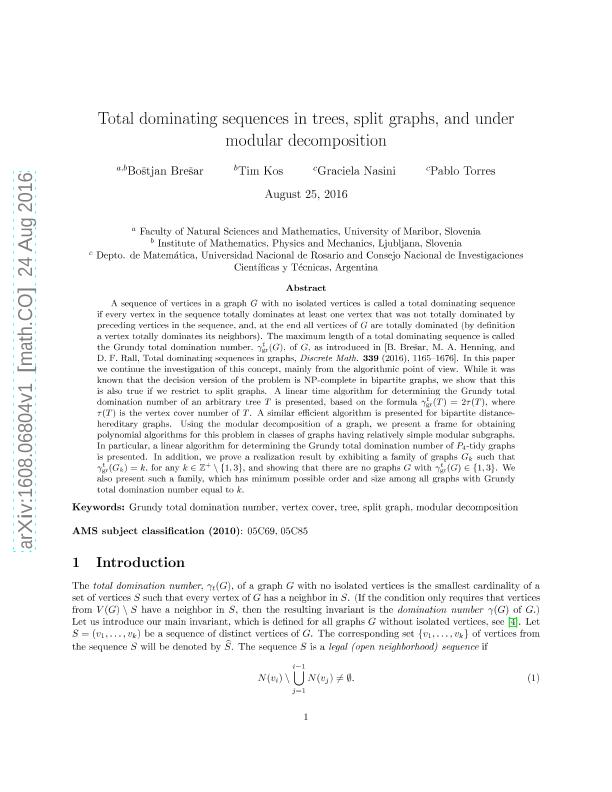Mostrar el registro sencillo del ítem
dc.contributor.author
Brešar, Boštjan
dc.contributor.author
Kos, Tim
dc.contributor.author
Nasini, Graciela Leonor

dc.contributor.author
Torres, Pablo Daniel

dc.date.available
2020-11-05T19:11:21Z
dc.date.issued
2018-05
dc.identifier.citation
Brešar, Boštjan; Kos, Tim; Nasini, Graciela Leonor; Torres, Pablo Daniel; Total dominating sequences in trees, split graphs, and under modular decomposition; Elsevier Science; Discrete Optimization; 28; 5-2018; 16-30
dc.identifier.issn
1572-5286
dc.identifier.uri
http://hdl.handle.net/11336/117720
dc.description.abstract
A sequence of vertices in a graph G with no isolated vertices is called a total dominating sequence if every vertex in the sequence totally dominates at least one vertex that was not totally dominated by preceding vertices in the sequence, and, at the end all vertices of G are totally dominated (by definition a vertex totally dominates its neighbors). The maximum length of a total dominating sequence is called the Grundy total domination number, γgr t(G), of G, as introduced in Brešar et al. (2016). In this paper we continue the investigation of this concept, mainly from the algorithmic point of view. While it was known that the decision version of the problem is NP-complete in bipartite graphs, we show that this is also true if we restrict to split graphs. A linear time algorithm for determining the Grundy total domination number of an arbitrary forest T is presented, based on the formula γgr t(T)=2τ(T), where τ(T) is the vertex cover number of T. A similar efficient algorithm is presented for bipartite distance-hereditary graphs. Using the modular decomposition of a graph, we present a frame for obtaining polynomial algorithms for this problem in classes of graphs having relatively simple modular subgraphs. In particular, a linear algorithm for determining the Grundy total domination number of P4-tidy graphs is presented. In addition, we prove a realization result by exhibiting a family of graphs Gk such that γgr t(Gk)=k, for any k∈Z+∖{1,3}, and showing that there are no graphs G with γgr t(G)∈{1,3}. We also present such a family, which has minimum possible order and size among all graphs with Grundy total domination number equal to k.
dc.format
application/pdf
dc.language.iso
eng
dc.publisher
Elsevier Science

dc.rights
info:eu-repo/semantics/openAccess
dc.rights.uri
https://creativecommons.org/licenses/by-nc-nd/2.5/ar/
dc.subject
GRUNDY TOTAL DOMINATION NUMBER
dc.subject
MODULAR DECOMPOSITION
dc.subject
SPLIT GRAPH
dc.subject
TREE
dc.subject
VERTEX COVER
dc.subject.classification
Matemática Pura

dc.subject.classification
Matemáticas

dc.subject.classification
CIENCIAS NATURALES Y EXACTAS

dc.title
Total dominating sequences in trees, split graphs, and under modular decomposition
dc.type
info:eu-repo/semantics/article
dc.type
info:ar-repo/semantics/artículo
dc.type
info:eu-repo/semantics/publishedVersion
dc.date.updated
2019-04-05T16:14:46Z
dc.journal.volume
28
dc.journal.pagination
16-30
dc.journal.pais
Países Bajos

dc.journal.ciudad
Amsterdam
dc.description.fil
Fil: Brešar, Boštjan. University of Maribor; Eslovenia. Institute of Mathematics, Physics and Mechanics; Eslovenia
dc.description.fil
Fil: Kos, Tim. Institute of Mathematics, Physics and Mechanics; Eslovenia
dc.description.fil
Fil: Nasini, Graciela Leonor. Consejo Nacional de Investigaciones Científicas y Técnicas. Centro Científico Tecnológico Conicet - Rosario; Argentina. Universidad Nacional de Rosario. Facultad de Ciencias Exactas Ingeniería y Agrimensura. Escuela de Ciencias Exactas y Naturales. Departamento de Matemática; Argentina
dc.description.fil
Fil: Torres, Pablo Daniel. Consejo Nacional de Investigaciones Científicas y Técnicas. Centro Científico Tecnológico Conicet - Rosario; Argentina. Universidad Nacional de Rosario. Facultad de Ciencias Exactas Ingeniería y Agrimensura. Escuela de Ciencias Exactas y Naturales. Departamento de Matemática; Argentina
dc.journal.title
Discrete Optimization

dc.relation.alternativeid
info:eu-repo/semantics/altIdentifier/doi/http://dx.doi.org/10.1016/j.disopt.2017.10.002
dc.relation.alternativeid
info:eu-repo/semantics/altIdentifier/url/https://www.sciencedirect.com/science/article/pii/S1572528617302293
dc.relation.alternativeid
info:eu-repo/semantics/altIdentifier/url/https://arxiv.org/abs/1608.06804
Archivos asociados
